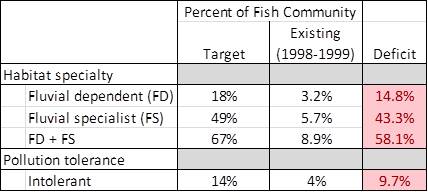Baseline Data: 1998-1999 Last Updated: 1998-1999
**Target and existing fish community data is currently only available for the Ipswich River watershed**

Fish community structure can be an important indicator of a well functioning aquatic ecosystem. Well functioning river systems should support a wide range of fishes including a diversity of habitat generalist and specialist species. Highly impacted systems tend to be dominated by species that are more generalist in their life histories and can tolerate wider ranges of temperature, oxygen availability and pollution levels. Studies in the Ipswich and other Massachusetts Rivers have shown links between water withdrawals and reduced abundance of fluvial (flow dependent) fish species (D. S. Armstrong et al. 2011). Target fish communities are a tool to allow for comparison between current community structure and what would be expected in a minimally impacted system (Bain & Meixler 2008). In 2001, a task group of experts developed a target fish community for the Ipswich River Watershed (Lang et al. 2001). While this target community was developed specifically for the Ipswich watershed, it should be generally applicable to the Parker and Essex as well. Comparisons of that target community and the community that was observed in 1998-1999 are shown below based on habitat requirements and pollution tolerance. As restoration efforts progress, we would expect to see the fish community begin to look more like the target fish community.


References
Bain, M.B. & Meixler, M.S., 2008. A Target Fish Community to Guide River Restoration. River Research and Applications, 24(4), pp.453–458.
Lang, V. et al., 2001. Appendix: Target Fish Community for The Ipswich River,
